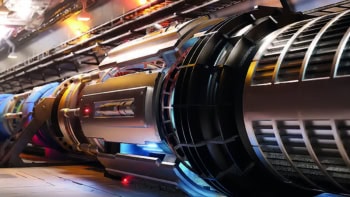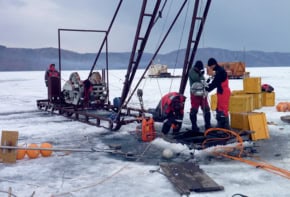
The internal structures of nuclei containing mirrored numbers of protons and neutrons have been studied to a high degree of precision. The research has revealed that neutrons are more prone than protons to modifying their internal structure when bound up in nuclei, and it could help resolve an important mystery of nuclear physics.
The study was done by the international Jefferson Lab Angular Momentum (JAM) collaboration using data from the MARATHON experiment, which is at the Thomas Jefferson National Accelerator Facility in the US. The team’s results could help physicists better understand how quarks are distributed inside protons and neutrons and why these distributions are different when protons and neutrons are incorporated within nuclei.
The proton comprises two up quarks and a down quark, whereas the neutron contains two down quarks and an up quark. Since 2018, MARATHON has used beams of high-energy electrons to probe how these quarks are distributed within protons and neutrons. When fired at ultra-cold targets, these electrons undergo deep inelastic scattering as they interact with quarks. Afterwards, the scattered electrons are detected by a pair of high-resolution spectrometers.
Structure functions
By measuring the change in momentum of the electrons as they scatter, physicists can determine the arrangements of quarks inside protons and neutrons within the target nuclei. These distributions are described by the structure function of the proton or neutron.
For several decades physicists have known that the structure functions of free protons and neutrons are different from those of protons and neutrons bound up within nuclei. This is called the EMC effect – named after the European Muon Collaboration, which discovered it in 1983 – and it remains an important mystery of nuclear physics.
In their latest study, the MARATHON team measured the ratio of the structure functions of protons and neutrons in the simplest pair of mirror nuclei: helium-3 – which contains two protons and one neutron – and tritium (hydrogen-3), which has one proton and two neutrons. Studying mirror nuclei meant that several theoretical uncertainties were eliminated from their measurement of the ratio.
Stronger for down quarks
The team used a 10.59 GeV electron beam, which is the highest energy ever used to measure nucleon structure functions. Using a new error correction technique, they extracted the structure function ratio from their scattering data. They found that the EMC effect is stronger for down quarks than up quarks, which means that it has a greater effect of the structure of neutrons compared to protons.
While the results are in broad agreement with theoretical calculations and previous experimental work, they offer a significant improvement in accuracy.
In future studies, the team will aim to fine-tune their approach, allowing them to study nucleon structure functions within larger, more complex nuclei. Their results could open promising new routes to enhancing our knowledge of the strong nuclear force, which binds quarks together, as well as the mysterious origins of the EMC effect.
The research is reported in two papers in Physical Review Letters. One paper describes the Marathon experimental results and the other describes the JAM analysis.



